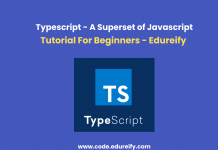JavaScript is one of the most important programming languages for Web Development. Edureify has previously talked about JavaScript in detail. Edureify’s coding Bootcamp job-ready courses also have informative and programming tool courses that interested students who would like to know and learn more about Java and other programming languages can take up.
In this article, Edureify presents the Higher-Order Functions in JavaScript. Read on to know more about the same.
What are Functions in Java?
Functions are the fundamental building blocks in JavaScript. JavaScript functions are a block of code that is designed to perform a particular task. “A function in JavaScript is similar to a procedure- a set of statements that performs a task or calculates the value, but not for a procedure to qualify as a function, it should take some input and return an output where there is some obvious relationship between the input and the output.”
Functions in JavaScript are first-class citizens. This means-
- One can assign functions to variables
- Use functions as arguments to other functions
- Return functions from functions
Defining Function-
A function definition also called a function declaration or function statement, consists of the function keyword which is followed by-
- Name of the function
- List of parameters to the function, enclosed in parentheses and separated by commas
- Curly brackets enclosed JavaScript statements that define the function, like this {…}
Example of a function that sums an array of numbers:
function calculate (numbers) { let sum= 0; for (const number of numbers) { sum= sum+number; } return sum; } Calculate ([1, 2. 4]); // => 7
Higher-Order Functions
Now that we have understood the function declaration, we will now talk about higher-order functions. “Higher-order functions are the functions that operate on other functions, either by taking them as arguments or by returning them.” Higher-order function is a term that comes from mathematics, where the distinction between functions and other values is taken more seriously. This feature of function allows the programmer to abstract over actions, not just values.
Some of the examples of higher-order functions built into the language are-
-
Array.prototype.map
-
Array.prototype.filter
-
Array.prototype.reduce
Array.prototype.map
The map() method enables making an array by calling the callback function that is provided as an argument on every element in the input array. The map() method will create a new array by using every returned value from the callback function.
The map() method accepts three arguments passed from the callback function. They are-
element, index, and array
Array.prototype.filter
All the elements that pass the test provided by the callback function can be created as a new array with the filter() method. The filter() method also accepts three arguments, and they are-
element, index, and array
Array.prototype.reduce
The reduce method results in a single output value after executing the callback function on each member of the calling array. The reduce method accepts two parameters-
- The reducer function– The reducer function further accepts four parameters: accumulator, currentValue, currentIndex, and sourceArray.
- initialValue– The initialValue is provided when the accumulator is equal to the initialValue and the currentValue is equal to the first element in the array. If no initialValue is provided, then the accumulator will be equal to the first element in the array, and the currentValue will be equal to the second element in the array.
Create your own Higher-Order Function
Higher-order functions are mostly built into the language itself. But one can create their own higher-order function also.
The following is an example of creating your own higher-order function-
In this example, we will create our own higher-order function where JavaScript does not have the native map method. In the following, we will convert an array of strings into an array of integers where each element represent the length of the string in the original array-
const strArray= [‘JavaScript’. ‘Python’, ‘PHP’, ‘Java’, ‘C’]; function mapForEach (arr, fn) { const newArray= []; for (let i= 0; i <arr.length; i++) { newArray.push ( fin (arr [i]) ) } return newArray; } const lenArray= mapForEach (strArray, function (item) { return item.length; }); // prints [10, 6, 3, 4, 1] console.log (lenArray) ;
So, here was the discussion with an example about higher-order functions. The key characteristic of a higher-order function is its ability to receive and return other functions as arguments and output.
Edureify, the best AI Learning App with its coding Bootcamp job-ready courses will help students learn new programming languages like Heroku, Ruby, Swift, and other key programming languages like PHP, Python, Java, C Language, and more. Students who would like to improve their technical skills can join our coding Bootcamp job-ready courses to kickstart their careers as web and application developers.
Some FAQs on Higher-Order Functions-
1. What are the functions in Java?
“A function in JavaScript is similar to a procedure- a set of statements that performs a task or calculates the value, but not for a procedure to qualify as a function, it should take some input and return an output where there is some obvious relationship between the input and the output.”
2. What is a higher-order function?
Higher-order functions are the functions that operate on other functions, either by taking them as arguments or by returning them.” The key characteristic of a higher-order function is its ability to receive and return other functions as arguments and output.
3. Mention the features of Functions in JavaScript that make them first-class citizens.
Functions in JavaScript are first-class citizens. This means-
- One can assign functions to variables
- Use functions as arguments to other functions
- Return functions from functions
4. What is the function of the array.protoype.filter?
All the elements that pass the test provided by the callback function can be created as a new array with the filter() method.
5. From where can I learn more about JavaScript?
Edureify has more information on JavaScript and other programming languages for students to learn.
Master Your Coding Skills with BootSelf AI
If you're looking to enhance your coding abilities and upskill in artificial intelligence, look no further than the BootSelf AI app. This innovative platform provides AI-based coding lessons that are tailored to your individual learning pace.
Available on both iOS and Android, you can download the BootSelf AI app and start mastering coding skills today:











